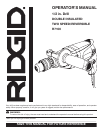
13
MAINTENANCE
Fig. 9
CHUCK REMOVAL
See Figure 9 - 10.
The chuck must be removed in order to use some
accessories. To remove:
n Unplug the drill.
n Open chuck jaws using the provided chuck key.
n Insert a 5/16 inch (8 mm) or larger hex key wrench into the
chuck of the drill and tighten the chuck jaws securely.
n Place an open-end wrench directly behind the chuck;
hold to prevent movement of the spindle.
n Tap the hex key wrench sharply with a mallet in a
clockwise direction. This will loosen the screw in the
chuck for easy removal.
n Open chuck jaws and remove hex key. Remove the chuck
screw by turning it in a clockwise direction.
NOTE: The screw has left hand threads.
n Insert hex key wrench in the chuck and tighten chuck
jaws securely.
n Tap sharply with a mallet in a counterclockwise direction.
This will loosen chuck on the spindle. It can now be
unscrewed by hand.
TO RETIGHTEN A LOOSE CHUCK
See Figure 9.
The chuck may become loose on the spindle and develop a
wobble when using the drill. Periodically check chuck screw
for tightness. A loose screw may cause the chuck jaws to
bind and prevent them from closing. To tighten, follow these
steps:
n Unplug the drill.
n Open the chuck jaws.
n Insert the hex key wrench into the chuck and tighten the
chuck jaws securely. Tap the hex key sharply with a mallet
in a clockwise direction. This will tighten the chuck on the
spindle.
n Place an open-end wrench directly behind the chuck;
hold to prevent movement of the spindle.
n Open the chuck jaws and remove the hex key wrench.
n Tighten the chuck screw.
NOTE: The chuck screw has left hand threads.
WARNING:
This tool should never be connected to a power
supply when you are assembling parts, making
adjustments, cleaning, performing maintenance, or
when the tool is not in use. Disconnecting the tool
will prevent accidental starting that could cause
serious injury.
Fig. 10


















